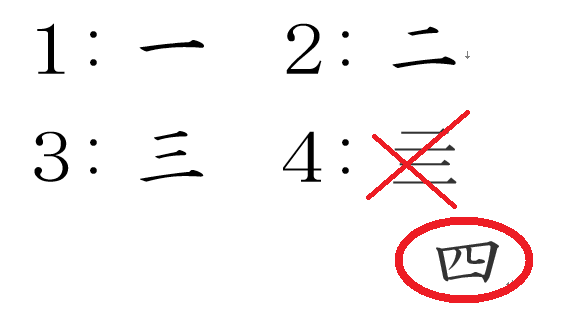
The history of the first kanji that makes many learners of Japanese want to pull their hair out, and why their initial guess isn’t entirely wrong.
One of the most intimidating things about learning Japanese is the writing system. There are three different sets of characters you’ll need to become proficient in, and while two of them, hiragana and katakana, aren’t too difficult to master, kanji, the set originally imported from China, is a high hurdle.
Japan’s Ministry of Education has designated 2,136 characters as “general-use kanji,” and while you may not need to know each and every one to function in Japanese society, you’ll need a firm mental grip on several hundred if you really want to integrate yourself into the cultural or professional spheres. With so many to learn, most structured courses, and self-studiers as well, start with the easiest kanji, ichi, which means one.
▼ Ichi

While you could possibly interpret a horizontal line in a few different ways, it’s not too hard to wrap your head around the fact that in Japan, a single sideways stroke represents the concept, and thus the word for, “one.” After inputting that in their brains, most learners will turn the page of their textbook and find the kanji for ni, or “two.”
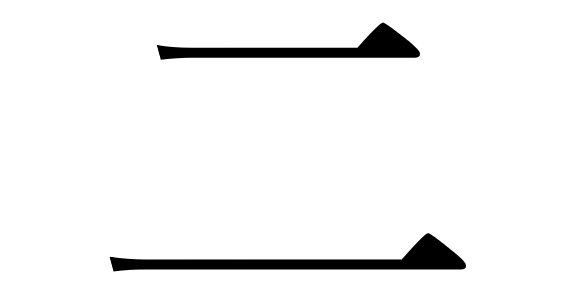
This seems like a pretty logical progression, right? One horizontal line means one, two horizontal lines means two. The next on the kanji study list is generally san, or “three,” and you can probably guess where this is going.
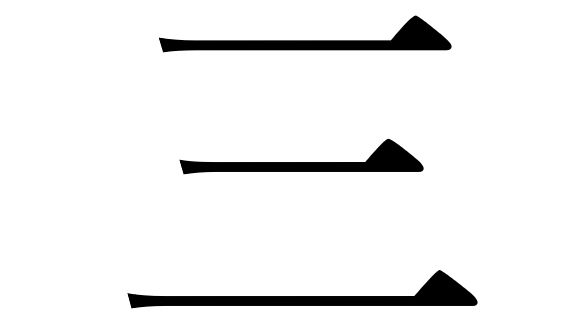
Wow, if all kanji are this straightforward, you’ll have those 2,136 general-use ones memorized in no time, right? Okay, let’s move on to yon, or “four,” although at this point it seems like just a formality, since in keeping with the established pattern it’ll probably be-
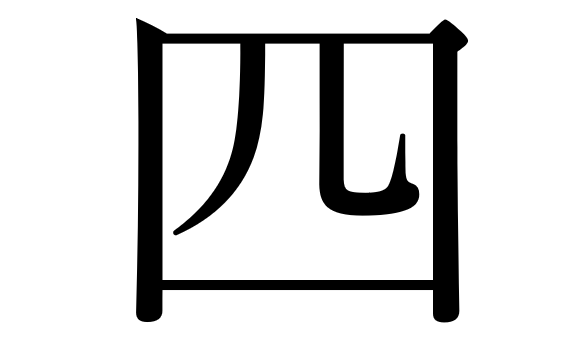
Whoa, hold up there. Is this some kind of joke? And if it is, don’t the people who developed kanji know that comedy is supposed to follow the rule of three, not the rule of four?
If there were any justice in the world, the kanji for “four” should be written like this, right?
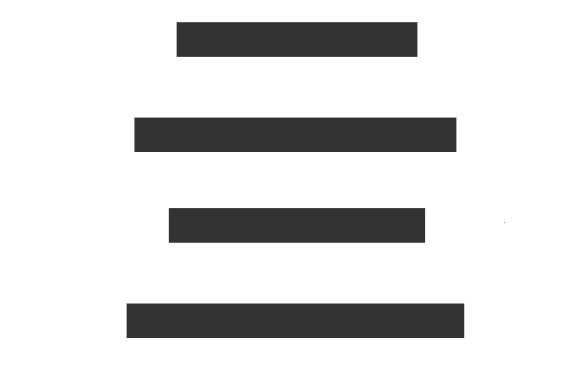
But try writing that on your kanji test, and your teacher is likely to strain a forehead muscle from cocking an eyebrow harder than he would if you referred to yourself with the macho pronoun ore when speaking in class. However, history would be on your side, even if your instructor probably wouldn’t, since long, long ago the kanji 亖 actually was an acceptable way of writing “four.”
▼ Take that, Teach!
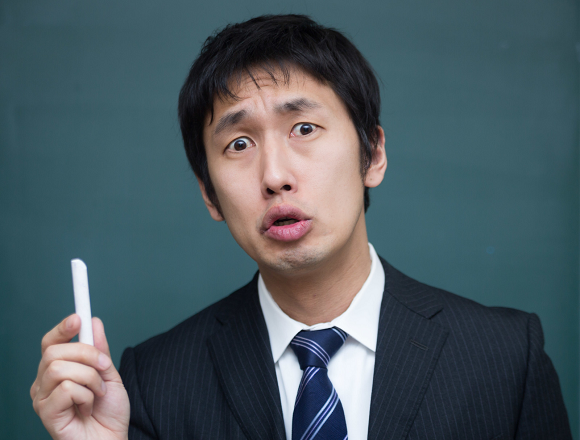
However, 亖 never shows up in contemporary usage, and it takes a fair bit of wrangling to even get it to appear when typing in Japanese (it’s literally easier to summon a dragon with a Japanese word processor than to produce the kanji 亖). So how did it get replaced, and why?
Let’s start with the “how” part of that question. As mentioned above, while Japan has developed some kanji of its own over the years, the writing system originally came from China. There, too, 亖 was once an acceptable way of writing “four.” However, somewhere along the line, people started using the kanji 四 to represent “four” as well.
四 seems like a strange choice at first. Originally, it meant “breath” and was meant to be a visual representation of teeth or a tongue inside a mouth (“mouth” by itself being written with the kanji 口). However, the Chinese pronunciations of 四 and 亖 were identical, and so some people started using 四 to represent “four.” Eventually, 四 became the preferred rendering for “four,” which then prompted the development of a new kanji for “breath,” 息 (a compound of the kanji for “self,” 自, and “heart,” 心).
But what turned popular opinion, and eventually society as a whole, against 亖? There was no official changeover decree, owing to language’s nature as a gradually and constantly evolving thing. However, the common-sense explanation is that while 一, 二, and 三 are all pretty easy to identify with a momentary glance, 亖 had moved beyond, or at least approached, the tipping point where the eye and mind can instantaneously process the information without requiring conscious counting.
From a practical standpoint, a line had to be drawn somewhere in stacking horizontal lines increasingly higher. After all, while the meaning of 八, the kanji for “eight,” may not be intrinsically understandable, it saves people from having to squint at small-font text to see if there are eight or nine strokes crammed together in a small vertical space. Others have pointed out that this concept that four repeating visual elements is too many appears in Roman numerals as well, which capped its vertical lines at three after Ⅰ, Ⅱ, and Ⅲ and then started mixing things up with Ⅳ.
So once again, yes, Japanese can be a difficult language to learn, sometimes frustratingly so. However, there’s often a reason for things being done the way they are.
Sources: IT Media, Okijiten (1, 2)
Top image ©SoraNews24
Insert images: SoraNews24, Pakutaso
Follow Casey on Twitter, where he’d like to thank Sakamoto-sensei for not getting too upset when he used “ore” during a heated in-class debate with another student.

 Japanese teacher shares surprising reason why the kanji for crow has one less line than bird
Japanese teacher shares surprising reason why the kanji for crow has one less line than bird Sweet high-school anime shows how learning kanji can be the key to getting a girlfriend【Videos】
Sweet high-school anime shows how learning kanji can be the key to getting a girlfriend【Videos】 10 badass four-character phrases to add to your Japanese language toolkit
10 badass four-character phrases to add to your Japanese language toolkit Japanese government tells teachers not to be so strict, at least about some kanji radicals
Japanese government tells teachers not to be so strict, at least about some kanji radicals Why does Japanese writing need three different sets of characters? (Part 2)
Why does Japanese writing need three different sets of characters? (Part 2) Starbucks Japan releases new drinkware and goods for Valentine’s Day
Starbucks Japan releases new drinkware and goods for Valentine’s Day We followed Tokyo’s mystery walking map and ended up creating our own bar-hopping adventure
We followed Tokyo’s mystery walking map and ended up creating our own bar-hopping adventure Fewer ramen restaurants declare bankruptcy in Japan for first time in several years
Fewer ramen restaurants declare bankruptcy in Japan for first time in several years Village Vanguard’s Blue Lucky Bag may have the most impressive piece of junk ever created
Village Vanguard’s Blue Lucky Bag may have the most impressive piece of junk ever created We try an unusual buffet of dishes made from wild game at a roadside stop in Chiba
We try an unusual buffet of dishes made from wild game at a roadside stop in Chiba Say hello to Japan’s new stationmaster cat!【Video】
Say hello to Japan’s new stationmaster cat!【Video】 Hokkaido has an Ice Festival that’s less famous than the Snow one, but beautiful in its own way
Hokkaido has an Ice Festival that’s less famous than the Snow one, but beautiful in its own way 7 great places to see Mt. Fuji from without having to climb it
7 great places to see Mt. Fuji from without having to climb it All 47 Starbucks Japan’s local Jimoto Frappuccinos, ranked by calorie count, plus what each one is
All 47 Starbucks Japan’s local Jimoto Frappuccinos, ranked by calorie count, plus what each one is Pizza Hut releases a turtle pizza that looks like a Teenage Mutant Ninja Turtle
Pizza Hut releases a turtle pizza that looks like a Teenage Mutant Ninja Turtle 10 times to avoid traveling in Japan in 2026
10 times to avoid traveling in Japan in 2026 Our 52-year-old pole dancing reporter shares his tips for achieving your New Year’s exercise goal
Our 52-year-old pole dancing reporter shares his tips for achieving your New Year’s exercise goal Starbucks Japan releases new Frappuccino and latte for Valentine’s Day
Starbucks Japan releases new Frappuccino and latte for Valentine’s Day Ramen restaurant’s English menu prices are nearly double its Japanese ones, denies discriminating
Ramen restaurant’s English menu prices are nearly double its Japanese ones, denies discriminating Princess Mononoke magnets return just in time to treat yourself to awesome anime decorations
Princess Mononoke magnets return just in time to treat yourself to awesome anime decorations Umamusume anime girl plushie recalled for having parts she absolutely should not have【Pics】
Umamusume anime girl plushie recalled for having parts she absolutely should not have【Pics】 Giant hotel rooms in Osaka reflect the new non-niche face of travel in Japan.
Giant hotel rooms in Osaka reflect the new non-niche face of travel in Japan. Japanese women showing rebounding interest in giving Valentine’s Day chocolate【Survey】
Japanese women showing rebounding interest in giving Valentine’s Day chocolate【Survey】 We ate sushi made from Japan’s most expensive tuna ever【Taste test】
We ate sushi made from Japan’s most expensive tuna ever【Taste test】 Starbucks Japan ready to get Year of the Horse started with adorable drinkware and plushies【Pics】
Starbucks Japan ready to get Year of the Horse started with adorable drinkware and plushies【Pics】 7-Eleven Japan starts new temporary luggage storage service in over 300 branches
7-Eleven Japan starts new temporary luggage storage service in over 300 branches Disillusionment at Tsukiji’s tourist-target prices led us to a great ramen restaurant in Tokyo
Disillusionment at Tsukiji’s tourist-target prices led us to a great ramen restaurant in Tokyo Starbucks teams up with 166-year-old Kyoto doll maker for Year of the Horse decorations【Photos】
Starbucks teams up with 166-year-old Kyoto doll maker for Year of the Horse decorations【Photos】 Tokyo’s Tsukiji sushi neighborhood asks tour groups to stay away for the rest of the month
Tokyo’s Tsukiji sushi neighborhood asks tour groups to stay away for the rest of the month Survey asks foreign tourists what bothered them in Japan, more than half gave same answer
Survey asks foreign tourists what bothered them in Japan, more than half gave same answer Japan’s human washing machines will go on sale to general public, demos to be held in Tokyo
Japan’s human washing machines will go on sale to general public, demos to be held in Tokyo We deeply regret going into this tunnel on our walk in the mountains of Japan
We deeply regret going into this tunnel on our walk in the mountains of Japan Studio Ghibli releases Kodama forest spirits from Princess Mononoke to light up your home
Studio Ghibli releases Kodama forest spirits from Princess Mononoke to light up your home Major Japanese hotel chain says reservations via overseas booking sites may not be valid
Major Japanese hotel chain says reservations via overseas booking sites may not be valid Put sesame oil in your coffee? Japanese maker says it’s the best way to start your day【Taste test】
Put sesame oil in your coffee? Japanese maker says it’s the best way to start your day【Taste test】 No more using real katana for tourism activities, Japan’s National Police Agency says
No more using real katana for tourism activities, Japan’s National Police Agency says Starbucks Japan reveals new sakura drinkware collection, inspired by evening cherry blossoms
Starbucks Japan reveals new sakura drinkware collection, inspired by evening cherry blossoms Updated cherry blossom forecast shows extra-long sakura season for Japan this year
Updated cherry blossom forecast shows extra-long sakura season for Japan this year Human washing machine pods coming to Japanese hotels【Photos】
Human washing machine pods coming to Japanese hotels【Photos】 Why does Japanese writing need three different sets of characters? (Part 1)
Why does Japanese writing need three different sets of characters? (Part 1) W.T.F. Japan: Top 5 kanji with ironic meanings【Weird Top Five】
W.T.F. Japan: Top 5 kanji with ironic meanings【Weird Top Five】 Busty Japanese brushstroke calligraphy artist shares visual appeal in video series【Videos】
Busty Japanese brushstroke calligraphy artist shares visual appeal in video series【Videos】 What does a kanji with 12 “kuchi” radicals mean? A look at weird, forgotten Japanese characters
What does a kanji with 12 “kuchi” radicals mean? A look at weird, forgotten Japanese characters One simple kanji character in super-simple Japanese sentence has five different pronunciations
One simple kanji character in super-simple Japanese sentence has five different pronunciations How to write “sakura” in Japanese (and why it’s written that way)
How to write “sakura” in Japanese (and why it’s written that way) Japan’s Kanji of the Year announced for 2021, and it’s a familiar choice
Japan’s Kanji of the Year announced for 2021, and it’s a familiar choice Japan announces Kanji of the Year for 2019, and it was really the only logical choice
Japan announces Kanji of the Year for 2019, and it was really the only logical choice Japan’s Kanji of the Year announced, shows the bright and dark spots of 2024【Video】
Japan’s Kanji of the Year announced, shows the bright and dark spots of 2024【Video】 Foreigners misreading Japanese kanji of “two men one woman” is too pure for Japanese Internet
Foreigners misreading Japanese kanji of “two men one woman” is too pure for Japanese Internet W.T.F. Japan: Top 5 strangest kanji ever 【Weird Top Five】
W.T.F. Japan: Top 5 strangest kanji ever 【Weird Top Five】 Awesome Japanese elementary school teacher rewards kids who use independent learning on his tests
Awesome Japanese elementary school teacher rewards kids who use independent learning on his tests Flipping the kanji for “husband” upside-down reveals slightly worrying double meaning
Flipping the kanji for “husband” upside-down reveals slightly worrying double meaning The extremely violent backstory of how to write the word “take” in Japanese
The extremely violent backstory of how to write the word “take” in Japanese
Leave a Reply